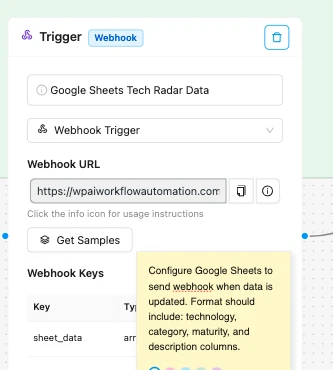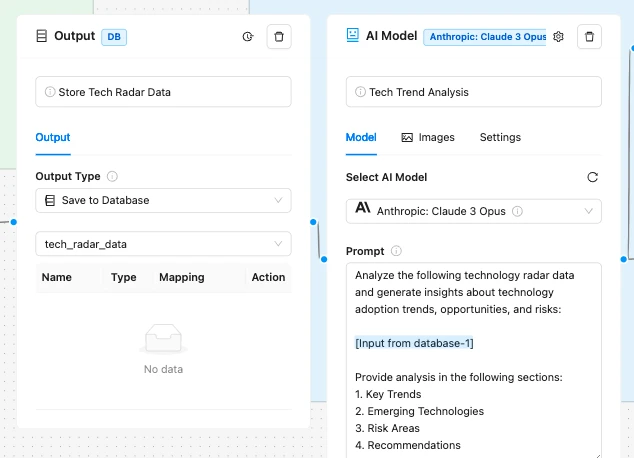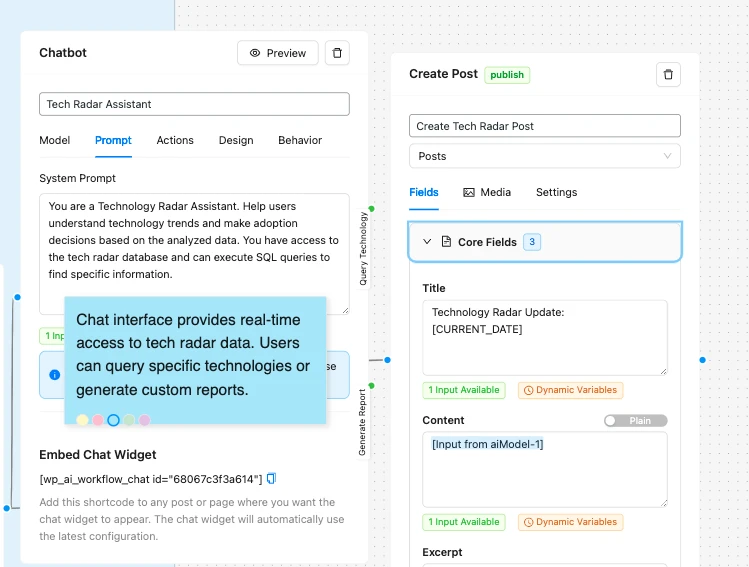Building an AI-Powered Tech Radar Advisor Workflow with Agentic AI
This article demonstrates how to create an AI-Powered Tech Radar Advisor Workflow using the AI Workflow Automation plugin. By leveraging agentic AI capabilities, this workflow helps organizations visualize and guide their technology adoption strategy using data from Google Sheets and MySQL databases. The workflow automates data ingestion, processing, and output to provide insights and interactive user experiences.
Who Should Implement This AI Strategy?
Technology leaders and digital transformation experts should implement this AI strategy. These professionals need a centralized platform to analyze and visualize their organization’s technology adoption strategy. By integrating Google Sheets Integration Node, AI Model Node, WordPress Post Node, and Chat Node, they can efficiently make informed decisions and align their tech strategy with strategic initiatives.
What Operational Hurdles Does This Overcome?
This AI-powered Tech Radar Advisor workflow addresses several operational hurdles, including manual data handling, slow decision-making processes, and lack of real-time insights. The Google Sheets Integration Node automates data ingestion, removing the need for manual data entry. The AI Model Node performs semantic analysis, providing valuable insights without extensive human effort.
From Trigger to Result: Agentic Execution
The Tech Radar Advisor workflow begins with the Google Sheets Integration Node, which automatically ingests tech radar data from a shared Google Sheet. This data is then stored in a MySQL database using the Database Storage Node. The AI Model Node processes this data, utilizing the Claude 3 Opus Model to generate relevant insights. An AI-powered chat interface allows users to ask questions about the data, enhancing user engagement. Finally, the Post Node creates WordPress posts to display these insights and advisory content, completing the agentic AI workflow.
Essential Plugin Features
-
- Google Sheets Integration: Automates data ingestion from Google Sheets, streamlining the data collection process.
-
- AI Model Node: Utilizes AI models like Claude 3 Opus to perform advanced data processing and generate insights.
-
- Chat Node: Provides an interactive AI-powered chat interface for user queries and engagement.
-
- WordPress Post Node: Creates WordPress posts to display insights and advisory content generated from the data analysis process.
Building AI-Powered Tech Radar Advisor Workflow
Step 1: Trigger Setup
To initiate the Tech Radar Advisor workflow, configure the Google Sheets Integration Node to automatically ingest tech radar data from a shared Google Sheet. This node ensures that the latest data is available for analysis without manual intervention.

Step 2: Database Processing
Use the Database Storage Node to store the ingested data into a MySQL database. This step leverages WordPress’s existing database capabilities, ensuring structured and efficient data storage for subsequent analysis.

Step 3: AI Processing
Configure the AI Model Node to perform semantic analysis on the stored data. Using the Claude 3 Opus Model, this node extracts valuable insights, enabling organizations to understand their tech adoption patterns and areas for improvement.
Step 4: Interactive AI Chat
Set up the ChatBot Node to provide an interactive AI-powered chat interface. Users can ask questions about the tech radar data, and the chat node can handle various queries, including SQL execution and topic-specific searches, enhancing user engagement and understanding.

Step 5: Output
Finally, utilize the Post Node to create WordPress posts. These posts display the insights and advisory content generated from the AI analysis, making the information accessible to the broader organization and stakeholders.
Customizing Your AI-Powered Tech Radar Advisor
To further customize this workflow, consider using workflow templates available within the AI Workflow Automation plugin. These templates can help you quickly set up similar workflows tailored to your organization’s specific needs, enhancing flexibility and efficiency.
Maximizing the Benefits of Agentic AI
Agentic AI, as implemented in this workflow, executes tasks autonomously, from data ingestion to insight generation and user interaction. By leveraging AI Model Node capabilities, organizations can automate complex decision-making processes, freeing up human resources for more strategic activities. The Chat Node further enhances this autonomy by providing real-time assistance and answers to user queries, making the workflow truly agentic.
Overcoming Workflow Challenges with AI Agents
Traditional manual processes often face bottlenecks in data handling and insight generation. The AI-Powered Tech Radar Advisor Workflow addresses these challenges by utilizing AI agents. These agents, powered by the AI Model Node and Chat Node, streamline the workflow, ensuring that data is processed and insights are generated quickly and efficiently.
Autonomous Workflow Mechanics
The mechanics of this workflow are fully autonomous, driven by the capabilities of the AI Workflow Automation plugin. The Google Sheets Integration Node triggers the workflow, followed by automated data processing using the Database Storage Node. The AI Model Node performs intelligent analysis, creating actionable insights. Finally, the Chat Node and Post Node deliver these insights in an engaging and accessible manner, demonstrating the power of agentic AI in workflow automation.
Conclusion
The AI-Powered Tech Radar Advisor Workflow represents a significant advancement in how organizations can leverage agentic AI to enhance their technology adoption strategies. By utilizing the AI Workflow Automation plugin’s capabilities, including the Google Sheets Integration Node, AI Model Node, Chat Node, and Post Node, businesses can automate data processing, generate valuable insights, and deliver these insights in an interactive and user-friendly manner. This workflow not only streamlines operational processes but also empowers technology leaders and digital transformation experts to make informed decisions efficiently.